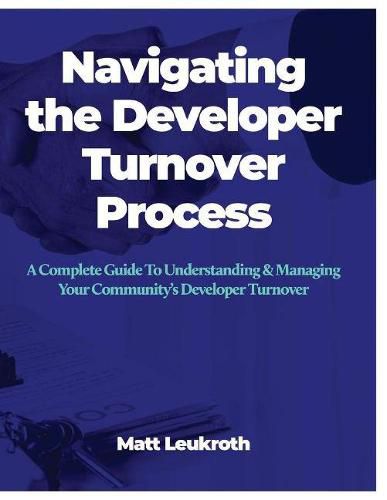Readings Newsletter
Become a Readings Member to make your shopping experience even easier.
Sign in or sign up for free!
You’re not far away from qualifying for FREE standard shipping within Australia
You’ve qualified for FREE standard shipping within Australia
The cart is loading…






The transition from developer control to resident control is a challenging time for any community. Reality is that a majority of people buying into deed restricted community associations don’t truly understand the extent to which they are binding themselves to the covenants, conditions, and restrictions inherent to their new home ownership. What’s worse, homebuyers purchasing into a community association while still under developer control fail to understand the degree to which the developer maintains control over their community, or the complexity of the process for transitioning to resident control.
Residents living in developer-controlled communities have a natural tendency to assume the worst of the developer’s actions and motives. So when the time comes for the developer to hand off an association to resident control (the developer turnover), more often than not, residents feel an overwhelming need to protect themselves and their community from the developer during the turnover process.
The anxiety surrounding developer turnover can be mitigated by better understanding the process and everything that may be involved for the residents taking control. Clarity of association responsibility versus developer responsibility is the basis of any turnover negotiation, and knowledge of your association assets, infrastructure, and equipment will go a long way toward sidestepping typical pitfalls and you navigate the process.
This guidebook is written for the community volunteers that recognize the need for resident involvement and oversight through the turnover process. Those that step up to form early governance for their community during a developer turnover need all the help they can get while planning and preparing for assumption of control.
If your community is a condominium or a homeowners association, this guidebook will provide you detail of all that a turnover committee need consider, both in pre-turnover planning and diligence, as well as post-turnover guidance and business requirements. In addition to the text, readers will find included sample committee charters, board resolutions, cash flow template, document turnover checklists (condo and HOA), infrastructure checklist, turnover committee diligence checklist, post-turnover board business checklist, and more.
This is the complete guide for any brave sole involving themselves in a developer turnover for their community’s benefit. The information provided will invariably help educate and organize efforts for all those involved.
$9.00 standard shipping within Australia
FREE standard shipping within Australia for orders over $100.00
Express & International shipping calculated at checkout
The transition from developer control to resident control is a challenging time for any community. Reality is that a majority of people buying into deed restricted community associations don’t truly understand the extent to which they are binding themselves to the covenants, conditions, and restrictions inherent to their new home ownership. What’s worse, homebuyers purchasing into a community association while still under developer control fail to understand the degree to which the developer maintains control over their community, or the complexity of the process for transitioning to resident control.
Residents living in developer-controlled communities have a natural tendency to assume the worst of the developer’s actions and motives. So when the time comes for the developer to hand off an association to resident control (the developer turnover), more often than not, residents feel an overwhelming need to protect themselves and their community from the developer during the turnover process.
The anxiety surrounding developer turnover can be mitigated by better understanding the process and everything that may be involved for the residents taking control. Clarity of association responsibility versus developer responsibility is the basis of any turnover negotiation, and knowledge of your association assets, infrastructure, and equipment will go a long way toward sidestepping typical pitfalls and you navigate the process.
This guidebook is written for the community volunteers that recognize the need for resident involvement and oversight through the turnover process. Those that step up to form early governance for their community during a developer turnover need all the help they can get while planning and preparing for assumption of control.
If your community is a condominium or a homeowners association, this guidebook will provide you detail of all that a turnover committee need consider, both in pre-turnover planning and diligence, as well as post-turnover guidance and business requirements. In addition to the text, readers will find included sample committee charters, board resolutions, cash flow template, document turnover checklists (condo and HOA), infrastructure checklist, turnover committee diligence checklist, post-turnover board business checklist, and more.
This is the complete guide for any brave sole involving themselves in a developer turnover for their community’s benefit. The information provided will invariably help educate and organize efforts for all those involved.